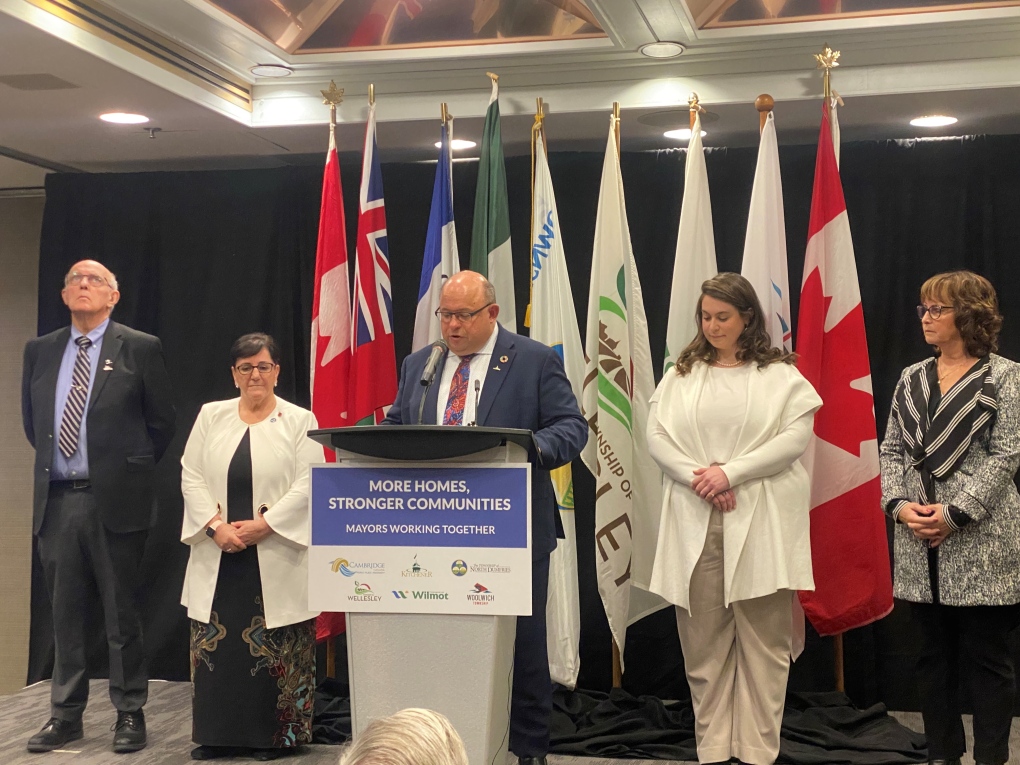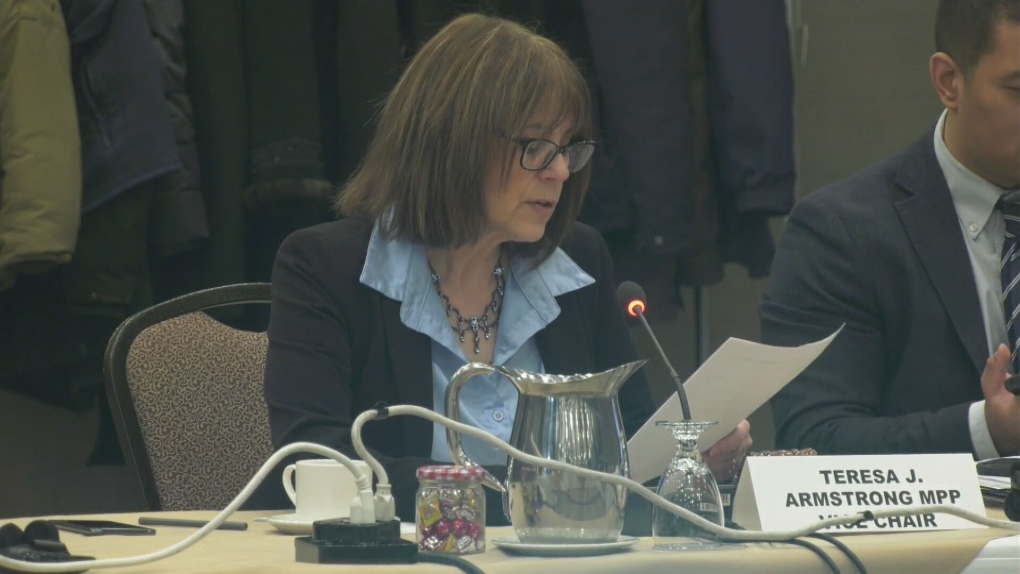To amalgamate or not? Residents, politicians weigh in
The future of governance in Waterloo Region was up for discussion Thursday, as a provincial committee tasked with studying the matter stops in Kitchener.
Possible options include maintaining or modifying the current two-tier structure, amalgamating all three cities and four townships into one single city, or breaking them apart into standalone municipalities.
Twenty-two people signed up to speak to the committee at the Crowne Plaza Hotel in Kitchener.
ARGUMENTS FOR AMALGAMATION
Among those advocating for amalgamation are regional councillors Jim Erb and Michael Harris.
“Waterloo Region has a population of 640,000 people, eight municipal councils, and 66 council positions. We are tripping over one another with elected municipal politicians,” Erb said in a written submission to the committee.
“As a reminder, and for the sake of comparison, with a population of approximately 515,000, the City of London has 16 council positions; the City of Hamilton, with a population of approximately 721,000, also has 16 council positions, and the City of Toronto, with a population of approximately 2.7 million, has 26 council positions.”
Harris shared similar sentiments, saying the current two-tier structure makes decision-making inefficient and slow.
“We are over governed and should be one municipality,” Harris told the committee, adding the majority of municipal services are already provided by the region.
Regional Chair Karen Redman also voiced support for centralizing more power within regional government, but stopped short of calling for amalgamation.
“Affordability depends on efficient service delivery in every corner of our Region. That is not happening right now,” she said in her submissions to the committee.
As an example, Redman said the Region of Waterloo is in charge of water supply and treatment, but the local municipalities oversee distribution of water and collection of wastewater.
“In simple terms, we provide the water, but five of our seven municipalities each build and operate their own individual pipe networks. That means developers have to deal with each municipality through individual permitting and servicing processes every time they try to build.”
MAYORS WANT MORE AUTONOMY WITHIN TWO-TIER SYSTEM
Meanwhile, in a joint news conference, the mayors of all but one of Waterloo Region’s townships and cities said they want more services, specifically those related to housing and development, transferred to their jurisdiction.
“In practical terms, the Region of Waterloo mayors support a reformed model of regional government where all existing municipal boundaries are maintained… and responsibility for services that directly support housing and development reside locally. These include all land use planning duties and local water and wastewater infrastructure,” Wilmot Mayor Natasha Salonen said.
She added the transfer of services to the local level could also include responsibility for roads, transportation, traffic control, culture, recreation, heritage, bylaw enforcement and, in the case of the townships, libraries.
 Wellesley Mayor Joe Nowak, North Dumfries Mayor Sue Foxton, Kitchener Mayor Berry Vrbanovic, Wilmot Mayor Natasha Salonen and Woolwich Mayor Sandy Shantz speak at a joint news conference calling for local government reforms. Cambridge Mayor Jan Liggett joined virtually. Waterloo Mayor Dorothy McCabe was notably absent. (Brandon Guitar/CTV Kitchener)
Wellesley Mayor Joe Nowak, North Dumfries Mayor Sue Foxton, Kitchener Mayor Berry Vrbanovic, Wilmot Mayor Natasha Salonen and Woolwich Mayor Sandy Shantz speak at a joint news conference calling for local government reforms. Cambridge Mayor Jan Liggett joined virtually. Waterloo Mayor Dorothy McCabe was notably absent. (Brandon Guitar/CTV Kitchener)
Kitchener Mayor Berry Vrbanovic noted that together, he, along with the mayors of Wilmot, Wellesley, Cambridge, North Dumfries and Woolwich represent almost 80 per cent of the region’s population and they share a common vision.
“We believe we are ready and can assume these services with the associated budgets from the region and believe we can deliver them faster and better for our residents by eliminating duplication,” Vrbanovic said.
The mayors also want to see some planning responsibilities transferred from the region to the local municipalities with the goal of cutting red tape to get housing built more quickly.
The only mayor that did not join the unified front was Waterloo's Dorothy McCabe. She told CTV News she was never invited to that conversation but feels as the area grows, a one-tier government is the best approach.
“Climate change, hybrid work, economic development, talent attraction, all those challenges, what's the best governance structure we need in place to meet those challenges? I believe it's one municipality,” McCabe said.
MORE PRESENTATIONS TO COMMITTEE
Of the first two speakers who addressed the committee Thursday, one voiced support for amalgamation while the other wanted to see the province make Cambridge a separate city.
“We’re Waterloo Region, we have a reputation for innovating, for being agile and changing the game when things aren’t working, but when it comes to how we function as a government, we’re stagnant, unwilling to fix what’s broken, eager to maintain the status quo,” said Melissa Durrell, a business owner and former Waterloo councillor.
“I believe our success has not been because of our complex and fragmented bureaucracy, it’s been in spite of it.”
 MPP Teresa J Armstrong opens the committee meeting at the Crowne Plaza Hotel in Kitchener. (Brandon Guitar/CTV Kitchener)
MPP Teresa J Armstrong opens the committee meeting at the Crowne Plaza Hotel in Kitchener. (Brandon Guitar/CTV Kitchener)
Cambridge Ward 8 city councillor Nicholas Ermeta told the committee he was speaking as a local resident, not a politician.
“Cambridge has a different culture than either Kitchener or Waterloo, we identify as Cambridge and there are many concerns in the community that regional policy has been slowly eroding our uniqueness and identity and residents do want the city to have a much greater say than it does now,” Ermeta said. “I believe we need more independence in order to move projects along quicker and better respond to the needs of residents.”
The committee meeting was scheduled to run until 6 p.m.
WHY IS THE PROVINCIAL GOVERNMENT STUDYING THIS?
In September, Housing Minister Paul Calandra announced he was scrapping a plan by his predecessor Steve Clark to appoint facilitators to review six two-tier governments in the province, including Waterloo Region.
Instead Calandra charged the Committee on Heritage, Infrastructure and Cultural Policy to take over.
“The committee can carry out this work in a manner that is transparent, accountable and open to the public,” Calandra said in September.
He said the study should examine whether two-tier governments in those regions support or hinder the construction of new homes and whether certain services could be combined or moved from one level of government to another.
Since last week, the committee has been traveling across southern Ontario, stopping in St. Catharines, Burlington, Brampton, Ajax and Vaughan to hear from residents.
CTVNews.ca Top Stories

Canada could impose tariffs on U.S. steel, orange juice in response to Trump threat
Canadian officials are narrowing a list of American products to target in the event the federal government must respond to U.S. tariffs on Canadian goods, CTV News has confirmed.
Convicted Jan. 6 rioter arrested as fugitive in Whistler, B.C.
An American citizen convicted of participating in the Jan. 6, 2021, riot on Capitol Hill who said he was seeking asylum in Canada has been arrested as a "fugitive from U.S. justice," according to authorities.
Can the U.S. really make Canada the 51st state?
Talk of Canada becoming the 51st American state has raised an existential question on this side of the border: Could it be done? Could the maple leaf make way to the stars and stripes? According to several experts, it may be possible, but not painless.
L.A. wildfires continue to devastate area, Canada prepared to offer expertise
A series of wildfires are searing through the Los Angeles area, forcing many to evacuate their homes. Here's everything that happened throughout Jan. 8.
'True when I said it, true today': former Canadian PM Harper pushes back against Trump on social media
Former Canadian Prime Minister Stephen Harper doesn’t find president-elect Donald Trump’s jibes about Canada becoming the 51st U.S. state very amusing.
Ontario Premier Doug Ford says he is 'OK' after OPP vehicle he was in was 'sideswiped' in Highway 401 collision
Ontario Premier Doug Ford was uninjured after an OPP vehicle he was travelling in was involved in a collision on Highway 401 earlier today.
At least 60 University of Guelph students sick as 'cluster of illness' hits residence
The University of Guelph is dealing with what they are calling a ‘cluster of illness’ among students living in residence.
Energy minister 'committed' to consumer carbon tax as he considers Liberal leadership
Energy and Natural Resources Minister Jonathan Wilkinson says he would be 'committed' to the consumer carbon tax should he become Liberal leader and prime minister, despite the policy’s unpopularity.
New ranking suggests Canada passport among 'top 5 losers' in the world
A new global ranking may raise doubts about Canada's reputation of being open to other countries.
































